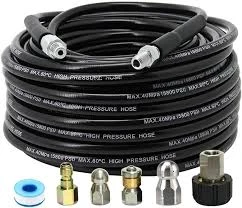R134a Refrigerant Charging Hose for Efficient System Maintenance and Repair
Understanding R134A Fill Hoses Essential Tools for HVAC Technicians
R134A refrigerant, or tetrafluoroethane, is a common coolant used in automotive air conditioning systems and various refrigeration applications. As HVAC technicians work with R134A, one of the critical tools in their arsenal is the R134A fill hose. This article explores the importance of R134A fill hoses, their functionality, and the best practices for using them safely and effectively.
What is an R134A Fill Hose?
An R134A fill hose is a specialized tool used to transfer refrigerant into a system that uses R134A. It typically consists of a durable rubber or flexible plastic tube with a fitting that connects to the refrigerant canister on one end and a service port on the vehicle or appliance on the other. These hoses are designed to handle high pressure and are equipped with specialized connectors to ensure a secure fit.
Importance of R134A Fill Hoses
Using a proper fill hose is essential for several reasons
1. Safety R134A operates under high pressure, and using a substandard or damaged hose can lead to leaks or ruptures, posing a risk to the technician. Approved fill hoses are built to withstand these pressures and are tested for safety.
2. Efficiency A quality fill hose allows for the effective transfer of refrigerant, minimizing waste. An efficient transfer saves both time and resources, which is particularly important for commercial HVAC operations.
3. Accuracy Many R134A fill hoses come with pressure gauges that enable technicians to monitor the amount of refrigerant being added. This feature helps ensure the system is charged correctly, preventing overcharging or undercharging, both of which can lead to system inefficiency.
4. Versatility R134A fill hoses can often be used in conjunction with various types of refrigerants, making them a versatile addition to any HVAC technician’s toolkit.
Types of R134A Fill Hoses
There are generally two types of R134A fill hoses available in the market
r134a fill hose

1. Single Hose A basic model that connects the refrigerant canister to the system’s low-pressure port. It is straightforward but can limit the efficiency of the charging process.
2. Manifold Gauge Set This setup includes two hoses—one for the high-pressure side and another for the low-pressure side—along with gauges to monitor pressure levels. This comprehensive system allows for precise readings and adjustments to ensure optimal performance of the HVAC system.
Best Practices for Using R134A Fill Hoses
To ensure safety and effectiveness when using R134A fill hoses, technicians should adhere to the following best practices
1. Inspect Before Use Always check the hose for leaks, cracks, or other damage before connecting it to the refrigerant source or system. A thorough inspection can prevent accidents and inefficiencies.
2. Use Proper Connection Techniques Follow the manufacturer’s guidelines for connecting and disconnecting the fill hose to avoid cross-threading or damaging the fittings.
3. Monitor Pressure While charging the system, keep an eye on the pressure readings. Each system has specific requirements, and adhering to these is crucial for optimal performance.
4. Avoid Overcharging Read the manufacturer’s specifications to determine the correct amount of refrigerant needed. Overcharging can lead to high pressure, which may damage the system.
5. Wear Protective Gear Always wear safety goggles and gloves when working with refrigerants to protect against potential exposure.
Conclusion
R134A fill hoses are indispensable tools for HVAC technicians working with R134A refrigerant. Their proper use ensures that cooling systems operate efficiently and safely. By understanding the various types of fill hoses available and adhering to best practices, technicians can enhance their service quality, ultimately providing better outcomes for their clients and extending the lifespan of HVAC systems. Whether you're a seasoned technician or a novice in the field, mastering the use of R134A fill hoses is essential for a successful career in HVAC.
-
Ultimate Spiral Protection for Hoses & CablesNewsJun.26,2025
-
The Ultimate Quick-Connect Solutions for Every NeedNewsJun.26,2025
-
SAE J1401 Brake Hose: Reliable Choice for Safe BrakingNewsJun.26,2025
-
Reliable J2064 A/C Hoses for Real-World Cooling NeedsNewsJun.26,2025
-
Heavy-Duty Sewer Jetting Hoses Built to LastNewsJun.26,2025
-
Fix Power Steering Tube Leaks Fast – Durable & Affordable SolutionNewsJun.26,2025

